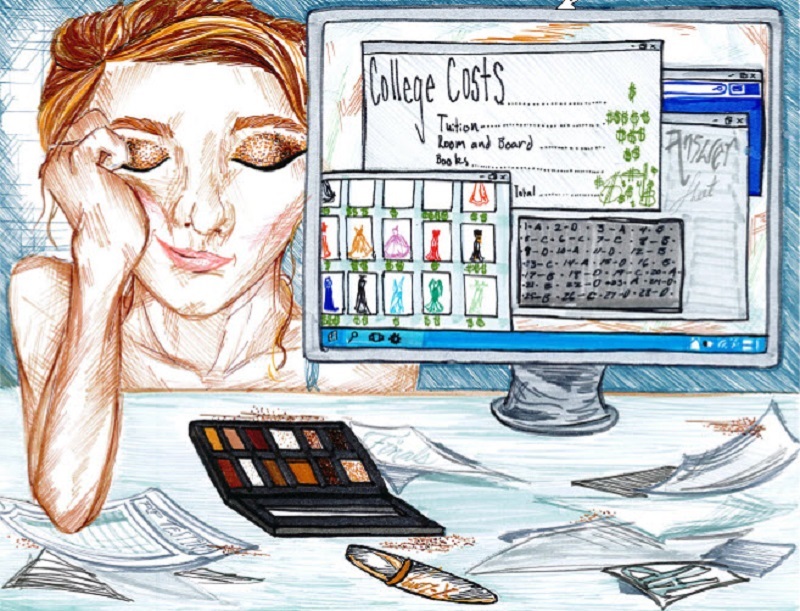A modern fairy tale
Prom is an iconic event for students, but it carries some negative consequences.
Teenagers weigh the benefits of prom against other issues in their lives
After scrubbing the floors and waiting on her family, Cinderella, a classic Disney Princess, prepares herself for the royal ball. Gus Gus and Jaq furiously work to drape silky strips of pastel pink ribbons around her rosey pink dress; however, Cinderella didn’t get her fairy-tale ending until later in the story as her dress was destroyed. Cinderella luckily had a fairy godmother to come and save her. Unfortunately, for high schoolers, their fairy godmother can’t make glorious dresses appear by simply saying “bippity boppity boo”. Prom has become a high school tradition that requires young adults to strive for perfection, meaning many use their bank accounts as their fairy godmother. Over time, prom has evolved into an image of a Hollywood production, or at least that’s what most teens dream of when prom season rolls around. The pressure put on prom and all that the event entails, dramatically outweighs any minor benefits this affair could hold. To see the flaws in prom, it is necessary to look at the cost, stress, and risks a single night can have.
Many young adults moving through their junior and senior year of high school are faced with the financial challenge of paying for college. The phrase “I am going to be the poor college kid” is constantly thrown around at the lunch table and in the hallways at school proving finances are on the minds of young people. However, when the first snowfall hits so do the first of many prom proposals. Rebecca Lake on May 6, 2016, published an article stating that prom costs a student on average 1,139 dollars, which for a broke college-bound student is a hefty amount of cash. Lake continues by saying even though parents typically pay 56 percent of the cost the other 44 percent of the weight falls onto the student. Now students who are frantically trying to dig up money for college are financially capable of dropping hundreds of dollars on one night of “fun”. In the big picture one night of entertainment should not limit what the future can hold, but with prom’s cost increasing the tradeoff could be up to eight college level credits.
The most discouraging part about the elevated cost of prom is that the average low-income family is spending more on prom than their richer counterparts. In April of 2015, the Philly Voice discussed this situation, explaining families that make less than 25,000 dollars per year spend about 1,393 dollars on prom versus that of a family who makes 50,000 or more dollars spend a mere 799 dollars. This disproportionate amount of money spent by lower class families can be alarming and uncalled for, but in many cases, these families don’t see that. Prom is viewed as a night that can elevate their child’s status, essentially these parents think the more money they pour into their kid’s look the better off the child is socially.
The pressure to fit in and become part of the popular crowd is not something that only low-income individuals face. In many situations, prom creates a monstrous amount of stress on females and males alike. A Psychology Today article posted in 2010 clearly details how the anticipation of prom is more stressful and exciting than the actual event. Pressure is put on prom night to be perfect, unfortunately, perfect isn’t always possible. This fact doesn’t stop teens from pushing themselves into the preformed mold of the idealized appearance. Red carpet mimics, fancy updo’s, manicured nails, professional tanning, flowers, flawless makeup and so many other tasks must be accomplished before the bell strikes midnight, prom night, causing teens stress levels to skyrocket in the weeks leading up to prom. Beyond the stress of taking high school level classes and managing hundreds of extracurriculars students must deal with the stress of finding the perfect date and then making all the prom arrangements. Today’s prom standards just add to the already monstrous level of stress teenagers face on a daily basis.
Stress about having a red carpet ready prom night leads students to participate in risky prom night endeavors. A multitude of reckless behaviors can occur on prom night including drinking and driving, sexual intercourse, and even sexual abuse. Although some of these risks are less common, they still impact many students as prom has over 4 million attendees nationwide. Statistic Brain, a website that tracks trending statistics, reveals that on prom night 54 percent of students drink four or more alcoholic beverages. Fear of getting in trouble causes many teens to get behind the wheel even when intoxicated. Drinking and driving during the peak of prom season has caused over 714 teenage deaths in 2008 states a New York Times article. The risks of teenage drinking and driving are monumental; however, they aren’t the only threats facing teenagers at prom. Another hazard females especially must be aware of is sexual assault or violence. Further in her article, Rebecca Lake explained that one in five girls are at risk of being sexually abused during prom season, which has both physical and emotional consequences. These negatives can be avoided with proper precautions, but the atmosphere of prom has rapidly changed into one where students come up with clever ways of spiking the punch resulting in harmful effects to themselves and everyone around them.
Prom for many teenagers is an iconic high school experience; however, with the new social norms changing prom has become a popularity contest. Any benefits one might pull from attending prom need to be weighed against the tremendous costs attendance would entail. When weighing these risks many young adults have chosen prom over the life-defining potentials, meaning they will have to deal with the consequences, as Cinderella’s fairy godmother can’t come save them.

Ella Coyle is an eighth grade Torch writer. She enjoys playing basketball and piano.

Carol Carpenter is the staff's only editorial cartoonist credited with the creation of the lantern logo. As a junior she participates in soccer and...

